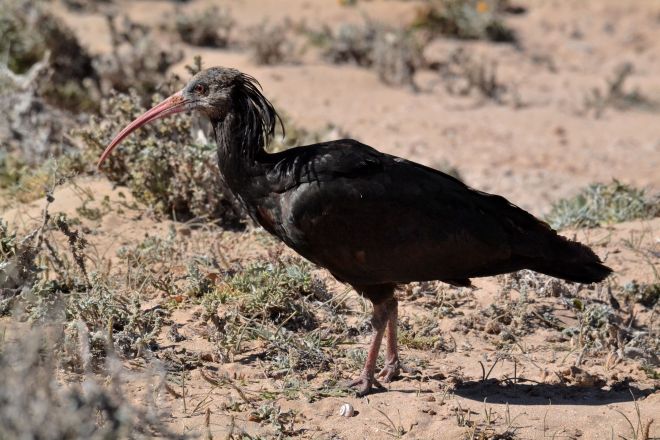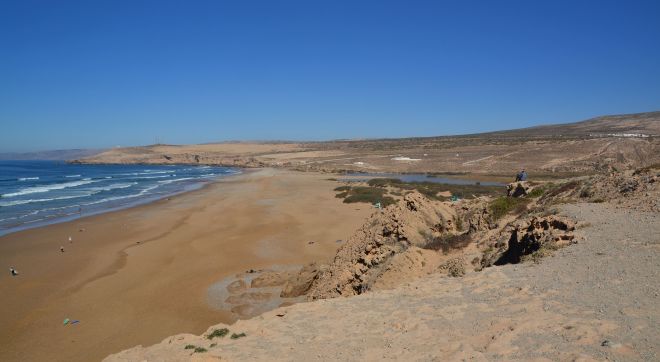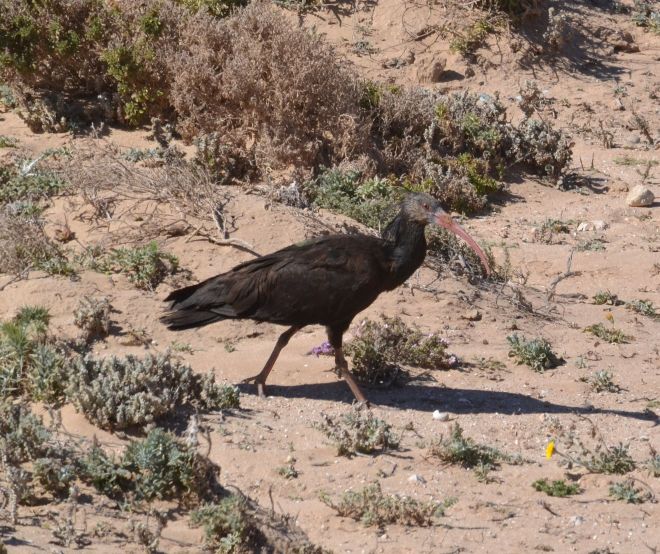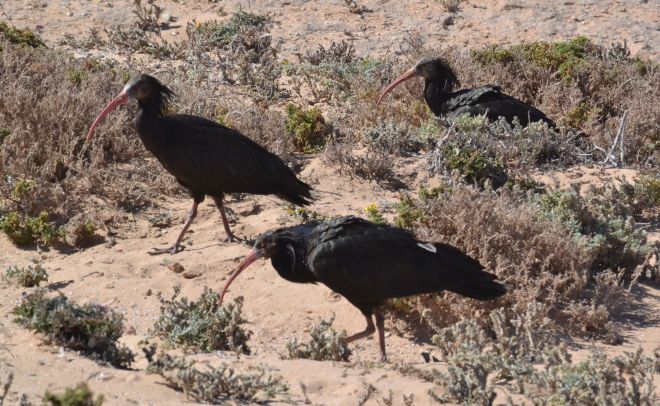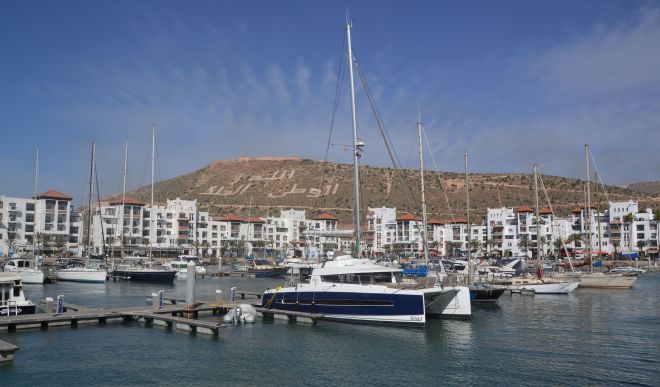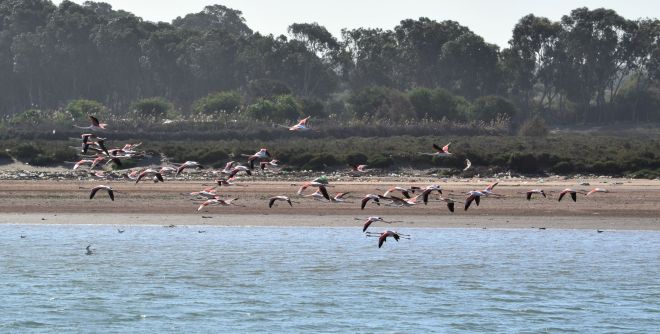As is my custom I began this trip with a walking day, out to the Kasbah hill and back. After climbing to the top with birds mostly in mind, then walking back down again I explored a gully that runs alongside a road around the hill’s western side. This struck me at once as likely good butterfly habitat, being sheltered with wild flowers in places, and it did not disappoint. I returned here for a couple of hours on three of the next four afternoons, recording 15 common species of the region including two lifers and a north-west African sub-species.
Near the top of any loose agenda I might have had for this trip was obtaining publishable pictures of Greenish Blacktip. This is a common and widespread butterfly of hot, dry, rocky places that occurs across north Africa, through the Middle East and as far as the Indian sub-continent. I had observed them during both my early year visits to Fuerteventura, but only gained pictures previously of worn individuals.
It now took all four of those above mentioned sessions to gain the open-winged picture in the above sequence (bottom, right). Interestingly this butterfly is nectaring on the same plant as the GBT captured by one of my Swedish field colleagues in Costa Calma last month (see here). Like our closely related Orange Tip at home this is a restless and fast flying species that only settles fleetingly, often on delicate, swaying perches; and they constantly relocate. But with perseverance I was able to gain some half-decent underside studies and so was largely satisfied with the outcome.
I was as pleased to find good numbers of bright yellow-toned Moroccan Orange Tip (pictured below) flying here. That welcome lifer frequents edges of cultivation, flowery places, woodland edges and scrub land as early as February in Morocco south of the Atlas Mountains but not until March further north. There are two sub-species, this one Anthocharis bella of the Maghreb region; and A b euphenoides that ranges through the Iberian peninsula into the far south of France. I had previously recorded the latter in Provence in May 2016 (see here).
All four of the species referred to so far are equally difficult to capture pictorially but now each is represented in this journal’s butterfly gallery. The African Grass Blue here were mostly well worn compared to those I observed in Fuerteventura, but the picture (below, top left) is quite pleasing. Since I am presently suffering from wear and tear in my left leg, performing the on hands and knees contortions that are required to gain acceptable pictures of such tiny butterflies was quite difficult.
I also hoped to locate African Babel Blue (above, bottom left) this week, that unbeknown to me at the time was on the wing in Costa Calma during my January visit there; but I was not successful. By way of partial compensation I did record the Maghreb sub-species of Common Blue (f celina), for which the clearest diagnostic appeared to be the broken black inner margin to the upper-side hind-wing (pictured above, right).
The week’s second lifer in the Agadir location was False Mallow Skipper (pictured below) that in the Maghreb region replaces the common and widespread Mallow Skipper of central and southern Europe. The two species are virtually impossible to tell apart in the field, being largely another male genitalia matter. FMS also ranges into the Iberian peninsula and a few Greek islands but the overlap between the two species is not fully understood. Bits job or not this was a further welcome addition of a tricky species to my life list.
Amongst more familiar butterflies Clouded Yellow (below left), Small Copper (below right), Wall Brown and Painted Lady were all well represented at this site; with smaller numbers of Cleopatra and southern Speckled Wood. Bath White (middle row, below) were looking nice and fresh, while the Small White here (bottom row) were of the pale toned first brood form.
Something a little more unusual was Spotted Fritillary (Melitaea didyma) of which a few were on the wing here at what must be the very beginning of their flight season. There are several forms of this species across its entire range and I believe those I encountered here were M d occidentalis that occurs in north-west Africa, the southern Iberian peninsula, the Balkans and Greece. I had only gained acceptable underside images of this butterfly previously, so the open-winged studies in this collage (below) were very welcome.
Through a rather hassle-prone week in Morocco I was never more content than when returning at the end of each day to this gully below the Kasbah, to prospect for butterfly pictures with nobody to bother me. That is the great benefit of an interest in insects, since wherever I might be in the world any piece of waste ground can be full of life and hence stimulating and motivating. There were also good numbers of slim, medium-sized, yellow toned dragonflies here that I suspect were immature Epaulet Skimmer, but they at no time settled. Elsewhere it was clearly the Odonata close season.
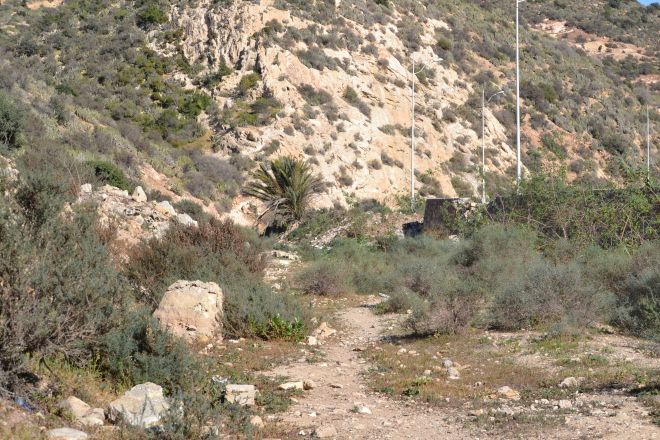
The roadside gully below Agadir’s Kasbah described in this post
The butterfly list for this trip (with lifers in bold) at this site and elsewhere was: Small White, Bath White, Greenish Blacktip, Moroccan Orange Tip, Clouded Yellow, Cleopatra, Small Copper, African Grass Blue, Lang’s Short-tailed Blue, Common Blue (f celina) , Plain Tiger, Red Admiral, Painted Lady, Spotted Fritillary, Speckled Wood (P a Aegeria), Wall Brown, False Mallow Skipper – 17

























